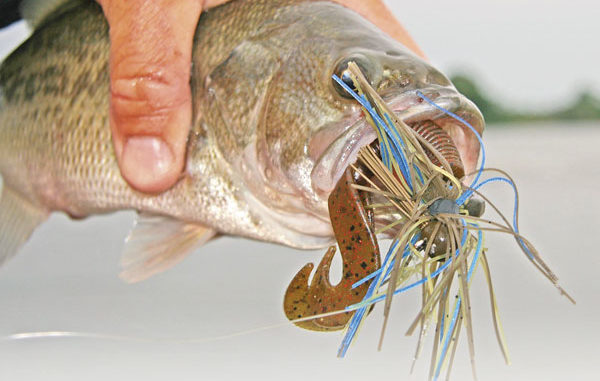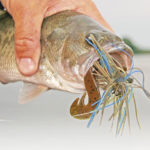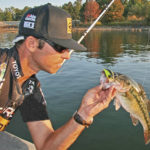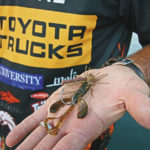
These anglers connect with bass in manmade shadows.
Man makes them, bass borrow them and man is just fine with that arrangement. Why? Because docks are to bass what offshore rigs are to red snapper — places of refuge, shelter and feeding opportunities.
Easier to reach than their saltwater counterparts, docks are more convenient to mark — be it with GPS or mental notes such as “blue and white boat,” “two jet skis,” or “red door on the boathouse.” There’s a sense of reason to dock fishing. You know where the structure starts and where it ends. There’s also the element of permanence — find a good dock today and barring a hurricane, it’s likely to be there tomorrow.
And while dock designs vary greatly in size and complexity, the fish will often determine some consistent criteria that define where they’ll be on a given day. Just ask Bassmaster Elite Series pro Greg Hackney.
“I like a lake with docks because you can usually pattern them pretty easily,” the Gonzales angler said. “Once you determine that pattern, you can normally run the whole lake and find that pattern just about everywhere.”
Dock deduction
When fishing dock-laden lakes like False River and D’Arbonne, Hackney’s particular about which structures he fishes. Sure, it typically takes some looking to define those patterns he seeks, but Hackney follows a mental checklist to narrow down the most likely spots.
“The first thing I look at is the time of year,” he said. “In the winter or summer, I look for a creek channel swing with some deep water close by. In the spring or fall, I’ll look for docks in protected areas like the backs of coves where the shad will gather.”
As far as dock style — floating or fixed pilings — Hackney has no strong preference. He does, however expect to find fish suspending more beneath floating docks, whereas he’ll look for fish holding closer to the bottoms of pilings on the pier-style structures.
Now, one element that Hackney actively seeks is the old-fashioned Styrofoam blocks under the more seasoned docks. Modern structures are mostly built with plastic flotation chambers, but the big white blocks, Hackney said, are worth looking for because they help attract the one thing bass can’t resist — food.
“You get a lot more algae growing on the Styrofoam than on the black plastic,” he said. “The shad eat the algae so they favor the Styrofoam more than the black plastic.
“If I can find a dock with Styrofoam, I’ll definitely look for that.”
On the flipside, Hackney’ fellow Elite Series competitor Mike Iaconelli knows that those black floats have their place in the plan, as well. Dark surfaces absorb more heat than lighter ones, so the docks with black floats become very attractive to shivering bass when late fall-winter finds lake temperatures in the chilly zone.
In any season, anglers are wise to consider the recreational focus of a dock’s owner. Each to his own, but some folks like to be near the water strictly for joy riding’s sake, while others are clearly focused on the perpetual pursuit of a tight line.
“If you see a dock with rod holders, there’s more likely to be people there who fish, as opposed to a dock with jet skis,” he said. “When you get around a dock where people fish, they usually put out brush to attract crappie. It suits the dock up and provides more habitat for bass.”
Tour the facility
Given that water surrounds all but the dock’s shore connection, the potential for finding bass extends well beyond its face. For Gerald Swindle, the Elite pro from Warrior, Ala., the dock plan starts with an all-inclusive view of the target, which, in most cases, comprises a walkway and some form of end structure such as a T, boat shed or pavilion.
The more substantial form of a dock’s terminal end first grabs the eye, and many anglers mistakenly stop there. Swindle warns against overlooking a dock’s full potential.
“Don’t just focus on the building and ignore the highway leading to it,” he said. “That fish uses a dock just like he uses an entire creek ledge. You really need to look at all of those areas. They’re a little aggravating and hard to get to, but they can be productive.”
Swindle finds that seasons greatly influence how bass position along a dock. During the temperature extremes of winter and summer, he expects to find fish at the ends in the deep, stable water. Fall highlights the midsections to the shoreward quarter, while spring sees spawning activity in the shallow end.
“Docks are great places for bass to spawn,” Swindle notes. “They get sun on them, they have the protection they need and they’ll spawn right up against those poles. And when their eggs hatch, their fry can hide under the docks.”
Speaking of “under the docks,” some waterfront homeowners do their best to minimize the accumulation of limbs, grass and other flotsam beneath their fixed docks by installing debris guards. That usually entails vertical slats with narrow spacing that greatly reduces one’s casting lanes. That may deter some, but not Swindle — he relishes the challenge.
“When I identify a dock with anything nailed down in the water, it’s almost like a No Trespassing sign,” he said. “Most fishermen would just go around that dock, but an alarm goes off in my head and that’s the one I’m just dying to throw under because those are generally the ones that are untouched.”
The jig is up
Hackney’s top choice for dock fishing is his namesake Hack Attack jig, and one of his favorite presentations is swimming. A more aggressive approach than flipping or pitching, this option shows the fish something they don’t often see and separates the window shoppers from the real customers.
“Swimming a jig is hard to beat around boat docks,” Hackney said. “They see a lot of spinnerbaits and crankbaits, but this gives them a different look.”
Hackney swims the ½-ounce jig with a Strike King Rage Craw trailer, and matches the bait to the prevalent forage.
“If they’re on shad, I’ll throw a white jig,” he said. “If they’re on bluegill, I’ll throw green or brown. I’ll look at the bluegill under the dock and see what color they are, and match my jig accordingly.”
Swindle notes that the swimming tactic is particularly effective during the post spawn when fish gather in the cooler water off the ends of deep docks. In most cases, though, he prefers skipping a 3/8-ounce Arkie jig with a green pumpkin Zoom twin-tail trailer. This tactic enables him to reach well into the sweet spots, while keeping his distance to avoid spooking the fish.
Using a 6-foot-10 Quantum Tour KVD spinnerbait rod and a 6.3:1 Quantum PT reel spooled with 20-pound Vicious fluorocarbon, Swindle uses a sharp sidearm cast and aims for a spot about 6 inches in front of the dock. This way, the bait makes contact with the water and then flattens out before skipping toward the gap between dock and water.
Aiming too close increases the risk of actually hitting the dock, and that’ll stop a bait’s progress — and alert the fish. Swindle does this for a living, so he makes it look easy; however, he said anyone can learn the right presentation by trusting their tackle and choosing precision over power.
“One thing that’s important for skipping docks is that you shouldn’t adjust your casting tension,” he said. “A lot of guys want to tighten down their reel so they don’t backlash, but you end up throwing too hard, and that makes you cast too high. Use your thumb to control the tension.”
Dock diversity
As effective as jigs may be, they’re certainly not the only option for tempting dock bass. One of Iaconelli’s favorites is the wakebait, and the inspiration for this dates all the way back to his childhood.
“As a kid, I grew up on a lake in the Poconos, and when I wasn’t fishing I was swimming off the dock,” Iaconelli said. “Any time I was swimming around the dock and I’d look up, I’d see bluegill around the foam of those floating docks.
“From when I was a kid until now, I’ve seen that. Whether it’s bluegill, shad spawning around the docks, or perch around the docks, that’s a killer pattern. If you look at the shape and profile of (that forage), a wakebait is a perfect imitator.”
Iaconelli prefers the Laser Lure SSD 0-1 for imitating bluegill or perch and Redfins for lanky baitfish like shad. Keeping his boat about 30 to 40 feet out from a dock, he’ll make his first cast as far back to the near side as possible. As he trolls forward, the cast works parallel to that side. Cast No. 2 passes the dock’s face, and the third shot borders the far side. Simple and efficient, the formula gives any hungry fish a good look.
“I like to fish all the edges, and for me, three casts can cover a dock,” Iaconelli said. “Some docks are more complex, but in general, it’s a great way to do that.
“You can cover a lot of water with a wakebait.”
Traditional topwaters like a Heddon Zara Spook or a Rebel Pop-R will interest plenty of dock fish, particularly when shad spawn around the docks. Another productive yet less common dock option is the hollow-body frog. California pro Ish Monroe fishes his namesake Snagproof PHAT Frog around docks coast-to-coast, and finds the bait’s ability to walk, chug and float motionless when paused provides great versatility.
“March through October, bass will follow bait schools, which position near food sources like bugs and algae,” he said. “Docks have shade for the baitfish, plus algae and bugs for them to eat.
“Everyone thinks that a frog only imitates a frog — but it also imitates a bluegill, a shad or a mouse. It imitates anything that’s in the water (or may end up in the water) that a bass is going to eat.”
During the cold season, a jerkbait can prove profoundly effective on tempting sluggish fish, as the erratic fluttering action and the suspending or slow-sinking action mimics the dying shad that provide an easy food source. Various models like the Rapala X-Rap, Megabass Vision 110 or Lucky Craft Pointer 100 sit differently in the water, but savvy anglers often adjust the sink rates and angles by upsizing treble hooks and/or adding adhesive lead strips to one end of the bait.
Plastics catch plenty of dock fish too, so don’t hesitate to pull a swimbait past the structure, or drop a Texas-rigged worm or lizard into the shadows. Hackney’s a big fan of shaky heads, and he enjoys the accuracy and versatility of throwing a 1/8-ounce head with a 4- or 7-inch finesse worm on spinning gear.
“I like the ability to put it in the right place,” he said. “If I can get a foot of clearance below the dock, I can get the shaky head all the way to the back, and it’s hard to do that with conventional tackle.”
Whatever you throw, Hackney said the key to consistent dock success is a diligent, open-minded approach: “The most import thing about a boat dock is to be thorough until you pattern the fish under them. Work shallow to deep on both sides to find the fish. Are they on the corners? Are they on the left side or the right side? Once you dial it in, you can pattern the entire lake.”





